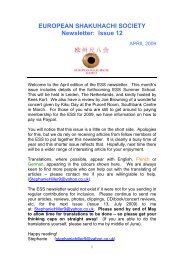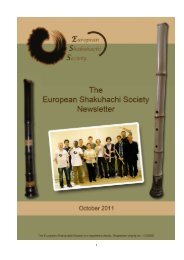first steps of a long journey with long flutes - European Shakuhachi ...
first steps of a long journey with long flutes - European Shakuhachi ...
first steps of a long journey with long flutes - European Shakuhachi ...
Create successful ePaper yourself
Turn your PDF publications into a flip-book with our unique Google optimized e-Paper software.
GORO YAMAGUCHI<br />
SHAKUHACHI MUSIC: A BELL RINGING IN THE EMPTY SKY<br />
NONESUCH EXPLORER CD<br />
BY CLIVE BELL<br />
Goro Yamaguchi (1933-99) studied the shakuhachi <strong>with</strong> his father, Shiro<br />
Yamaguchi, during the second world war, and quickly rose to<br />
recognition as a leading player. In 1967 he taught for a year at<br />
Wesleyan University in Connecticut, and while in the US recorded two<br />
honkyoku pieces in New York: “Sokaku-Reibo” and “Koku-Reibo”. In<br />
1969 these appeared on an LP in the Nonesuch Explorer Series, titled A<br />
Bell Ringing In The Empty Sky (the title taken from a colourful pseudotranslation<br />
<strong>of</strong> “Koku-Reibo”). Now Nonesuch have reissued the album<br />
on CD as part <strong>of</strong> their gradual re-release <strong>of</strong> the whole Explorer Series.<br />
The two tracks remain the same; the sleeve notes are unedited, though<br />
a bio <strong>of</strong> Yamaguchi has been added; but the wonderful monochrome<br />
psychedelia <strong>of</strong> the LP sleeve, in which a crane appears to fly through a<br />
geisha’s hair-do, has been replaced by a 1961 photo <strong>of</strong> a tiny fishing<br />
boat on the Inland Sea.<br />
It’s probably hard to overstate the impact <strong>of</strong> Yamaguchi’s original LP in<br />
the West. One has to think back to a benighted generation when not<br />
only had no one ever heard a shakuhachi, but the idea that Japanese<br />
music might have depth to it, that it might have a rigour that could stand<br />
a<strong>long</strong>side <strong>European</strong> classical performance, was thrillingly new and<br />
taboo-busting. Inviting Yamaguchi to teach at Wesleyan was a<br />
pioneering move, and A Bell Ringing was the <strong>first</strong> widely available<br />
recording <strong>of</strong> a completely new music. It took its place a<strong>long</strong>side Ravi<br />
Shankar, Stockhausen and Hawkwind on the shelves <strong>of</strong> discerning<br />
record buyers, and aspiring music-makers and composers marvelled at<br />
its qualities. By 1977 a portion <strong>of</strong> the recording was included on a<br />
compilation <strong>of</strong> “Earth Music” aboard the Voyager II spacecraft. Having<br />
conquered hip record stores, Yamaguchi was <strong>of</strong>f to new galaxies.<br />
How does Yamaguchi’s record stand up now, forty years on? The <strong>first</strong><br />
thing you notice is the overall length: at under thirty minutes, this is what<br />
we would now term an EP. Nonesuch clearly had no extra material in<br />
the vaults to flesh out the CD version. Having said that, Yamaguchi’s<br />
versions <strong>of</strong> these classic pieces are unusually <strong>long</strong>: “Sokaku” at thirteen<br />
minutes and “Koku” at fifteen represent extended explorations. The<br />
sleevenotes, despite being written by respected ethnomusicologist and<br />
broadcaster Fumio Koizumi, are misleading and, when it comes to<br />
scales, hilariously inaccurate. However there is an honourable tradition<br />
<strong>of</strong> album notes getting these things wrong, and if a sleevenote writer<br />
starts talking about scales it’s almost guaranteed that what follows will<br />
be nonsense.<br />
10




